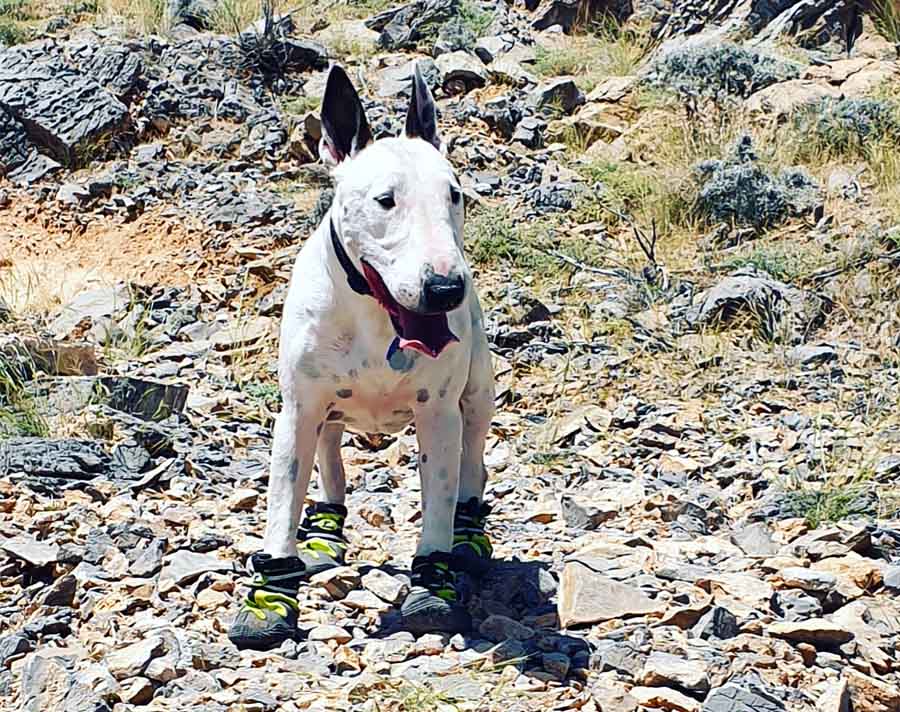While hiking with my dog for many years there have been a few times where I’ve had to carry my injured dog.
The best method to carry an injured dog on the hiking trails is the ‘over the shoulders method’. This method is used by the military and police dog squads and is proven to work over a long distance as it uses your body’s core strength.
However, carrying your dog over long distances is no easy task and the ‘over the shoulder method’ works depending on your fitness and strength level, the size of your dog and the injury your dog has. In doing this research I have discovered that there are many ways to carry a dog in this situation.
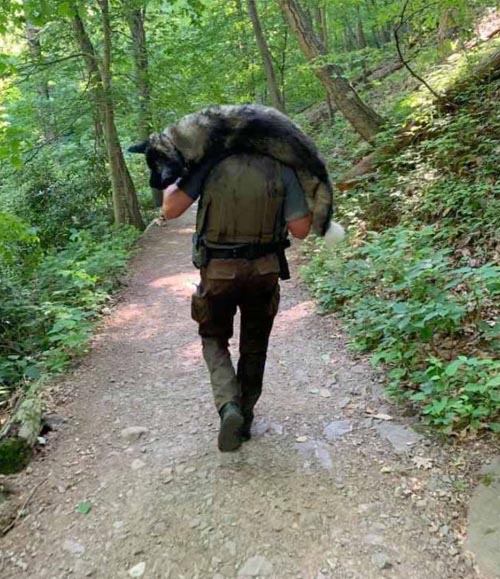
How to carry your injured dog on the trails or over long distance
The proven method of carrying a dog on trials is the ‘over the shoulder method’. I have had to do this on several occasions, where my dog injured his paws and was unable to walk.
This method, is also known as the ‘fireman’s lift’ relies on you dog lying across the back of your neck and shoulders with his legs in front of you and your head separating the front and back legs. This is not only manageable for you, but it is also comfortable for your dog.
If you have ever seen footage of police dog squads or army dog handlers in training, you might see that they carry the dog over their shoulders. This is a requirement for the dog and the dog handler to learn, just in case the dog is injured and the dog needs to be carried out of a dangerous situation.
It’s important that you and your dog also learn this before you actually need to do it. This way you will know what to expect, know how to lift your dog and your dog will be familiar with this experience, when he is injured.
I have outlined the steps below for you to learn this method and I have discovered other methods of carrying dogs, including carrying extra-large breeds. In writing this post I have discovered some products that would also be good to have out on the trials.
The ‘Over the Shoulders Method’
It’s a scary thought that you would have to carry your injured dogs out of a bad situation. I have had to do this three times, two of which were the result of cuts to my dog’s paws. Each time I choose the ‘over the shoulder method’ which is the same as the ‘fireman’s lift’ for carrying people over long distances.
It’s important however to note that this move needs to be practiced by you and your dog. I have found that suddenly putting a dog on your shoulders for the first time really freaks out the dog and all they want to do is jump off you. By doing this they can really injure their legs and scratch you in the process. So it is best to practice this activity at the beach where the water and the sand make for soft landing.
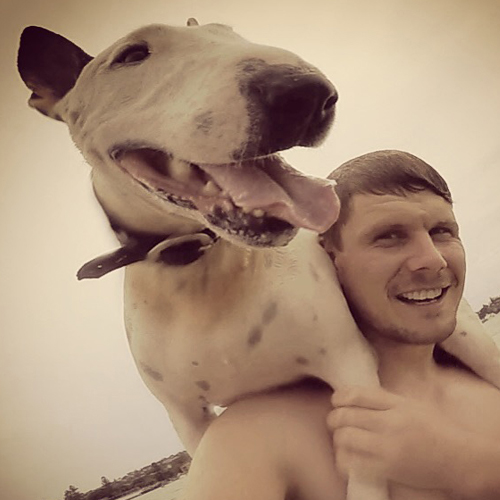
Step One
Take your dog to the beach or lake and both of you swim in the water. If your dog is scared read ‘How to teach your dog to swim at the beach’.
Step Two
Go to where the water level is at your chest height and your dog is swimming in front of you with the side of his body facing yours.
Step Three
swim under your dog’s legs and stand up so that his legs end up being either side of your neck and his body is resting on your shoulders when you stand up. While standing up, hold his legs firmly with your hands.
For bigger dogs you may find that he will straddle your shoulders where only his left legs are on your chest and is right legs are over your back.It’s important to do this when you are in the water, as the first few times your dog will find it strange and possibly jump off you into the water. Get him used to doing this and hold onto his legs and tell him No, if he shows any signs of jumping off. He is only allowed off when you have told him.
Pro tip – wear a t-shirt to reduce the scratches for when they jump off your shoulders.
Step Four
Once he is used to being on your shoulders, you can try shallower water until you are comfortable that he will listen and not jump off. The last thing you want is for him to jump off and hurt his leg.
The beach is always the best place to learn this because when you progress and build trust in shallow water, if he jumps, he will land on the sand and not hard ground.
Step Five
When you try this out of the water, after doing it many times, you may have to kneel down to get your head under your dog’s belly. This is best done where the dog is at a higher position. However, you may not always have this option.
So, it’s important to note that the weight distribution has changed being out of the water and it will be harder for you to do a safe lift.
Therefore its important to have a calm dog who is familiar with the task when doing this exercise. Use your core muscles and legs as much as possible for the lift and for a safe landing when you bend down. This will feel very awkward the first few times you do this.
Don’t worry about your dog doing these exercises. Your dog will often love the attention and think of this as a fun game. Most dogs love being up high and especially on your shoulders. It’s more importantly to avoid injury and to calm your dog’s excitement down so that they listen to you.
The Over One Shoulder Method
The ‘over one shoulder method’ is the second best method that is still used today as an alternative method in the military and police force. I find this method is better for a dog that is more restless.
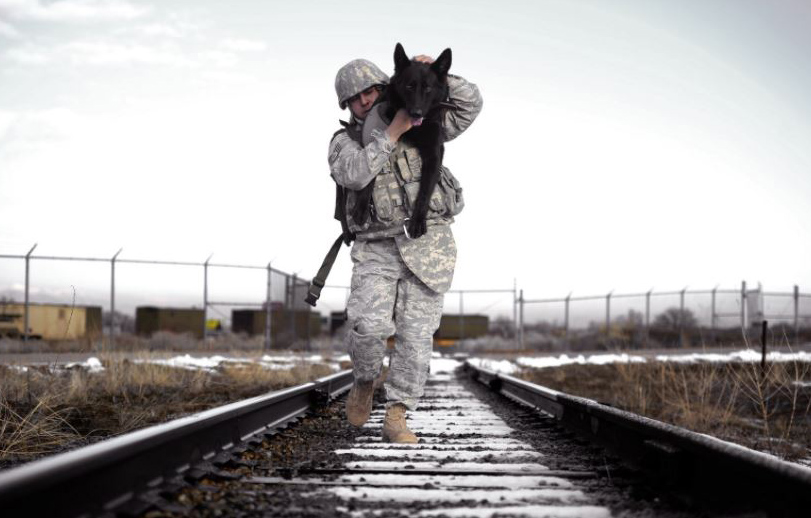
I believe this method is better for more restless dogs because they can see where they are going and are facing forward. However, this method does have its limitations for a sick dog as the dog needs to support itself. The method requires the dog to be alert and balance more on your shoulders.
This method is perfect for when you need to carry your dog over broken glass, or in a river with a strong current etc.
One of the main positives about this method is it is much easier to place the dog on your shoulders. However you need to do more work in helping the dog be balanced as they can tip forward or tip backward.
Step one
Stand alongside your dog and crouch down and place the arm closest to them under their belly and around their body. With your other hand at the same time hold their collar or harness and move them on top of your shoulder while standing up while supporting their weight.
Do this at the beach or where there is a soft landing.
Most dogs will be comfortable with their front legs on your chest as they can hold onto you better.
This method is even better if you are already carrying a backpack as it increases the surface area for the dog to rest on you.
In front Method or The Two Hand Hold
The front method of picking them up from the front by putting one arm in front of the dog’s chest and other arm behind his legs and tail where he is supported by your arms and chest.
This method is recommended when picking up the dog and placing them on something like the boot of a car, or the vets table. For carrying over distance I would only use this method for small dogs.
For larger heavier dogs, this method puts way too much strain on your lower core and back muscles over a long distance. This method should then only be used to pick up your dog and not carried.
See Animal Behavior College for more instructions.
Your dog Needs to Feel Comfortable and Secure
In all of these methods, your dog has to feel comfortable and secure. You need to be calm and confident with a firm grip because you will reassure your dog that you know what you are doing. I suggest for you to feel confident in knowing what you are doing, you need to practice.
Practicing this when you’re at the beach can be a fun activity to do with your dog. It’s vital for you and your dog to know these methods, just in case if your dog gets injured you will be confident in knowing that you can carry your dog to safety.
How to Carry an Extra-Large Dog on the Trails
Hiking with an extra-large dog breed does have its risks. If they were to get injured, you would not be able to carry them. Because of this fact you must plan for the worst just in case. Hiking with your extra-large breed can be done however, you should take measures to minimize the risk and ensure that if things go wrong you have a plan in place.
Here are some permitters to minimize the risk while hiking with your gentle giant.
- Do a hike that is easily accessible to your car and not too strenuous
- Do a hike with a group of people, so if he is injured you one person can stay with your dog and the other can get further help.
- Carry an Emergency Dog carrier pack (see below).
- Tell people where you are hiking and send them the route on the google maps.
If you do get stuck and need to get out of the trail, you could build a stretcher from two poles from branches and use some strong material in between such as a tarp or tent tied to the poles. For this you would need at least two people for this.
Making a sledge out of branches and pulling your dog will work across smooth ground. Many man made materials are perfect for this, doors, bin lids and car panels.
Apart from the extra-large hunting breeds, the majority of the extra-large dog breeds were not bred for sustained long endurance activities such as long hikes. If you would like to know more see our article Can Extra Large Dog Breeds Go Hiking. So it’s advised, to keep your hike accessible distance to your car and short enough to not over exhaust your dog.
See here how many people were needed to rescue Daisy the St Bernard from Scafell Pike England’s highest mountain
Pet Carrier Backpacks
Pet Carrier Backpacks are a great option if you have a small dog. Small dogs are great to hike with, because if they get tired you can carry them in a specifically designed backpack. This is perfect if you would like to ‘’keep moving’’ especially as sunlight is fading on the trails.
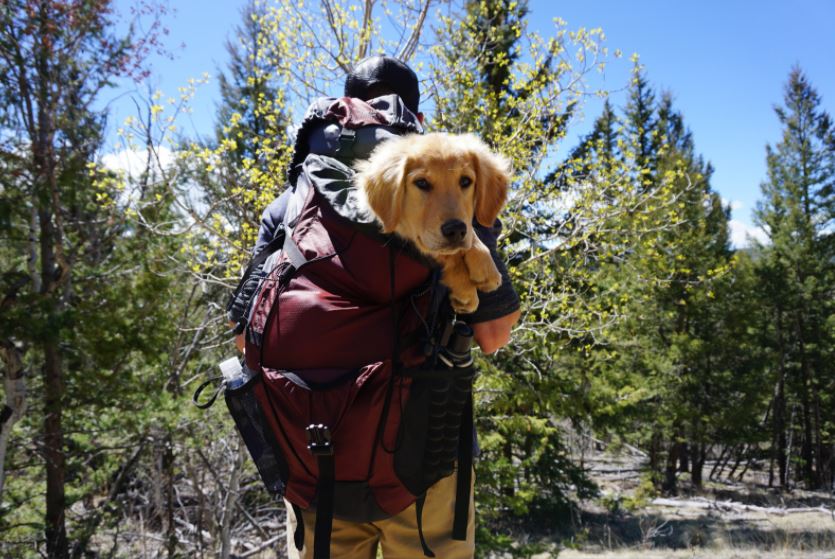
I’d opt for a pack that sits on your back and not in front however, if you have a very small dog this would be ok. Generally, you would want to keep the weight on your upper back.
I also prefer the packs where the dogs can fit inside the sack and are positioned on your upper back as much as possible. Our pick is the K9 Sports Sack Dog / Carrier Dog Backpack as it fully opens and easy to put on your dog while still allowing some movement for your dogs back legs in the base of the bag.
Emergency Dog Carrier Packs
There has been great development on Emergency dog carriers in the past few years. Products that you can throw into your backpack are great as they do not take up too much room and can be combined with your first aid pack. These products give you peace of mind on the trails in terms of extra options for carrying for a large dog over distance.
Products that I have found include the Airlift by Fido Pro and Black Rescue Harness
To Conclude
I hope that you wont experience a situation where you would have to carry your injured dog. However, many things can happen out on the trails and it is likely if you go often that you will have to carry your dog at some point.
In all outdoor activities there is risk, but this should not stop you from going and exploring the wild together. In my experience most of the issues happen to my dog’s paws such as cuts and scratches. This can be reduced by using dog hiking booties to minimize this risk. See my link to what I have used in the past for dog booties.
Practicing different carrying methods where it is safe to do so and if you really think you could benefit from a few more carrying options then do buy an emergency dog carrier or backpack.
